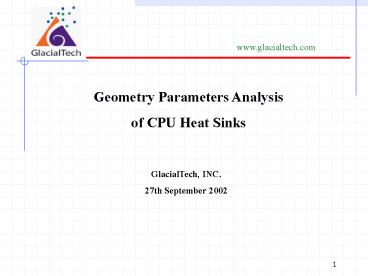Geometry Parameters Analysis - PowerPoint PPT Presentation
1 / 11
Title:
Geometry Parameters Analysis
Description:
To understand the effects of the geometry parameters for aluminum ... Check thermocouple. Keep environment temp. is 35?. Steady. Yes. No. Measure CPU temp. ... – PowerPoint PPT presentation
Number of Views:27
Avg rating:3.0/5.0
Title: Geometry Parameters Analysis
1
Geometry Parameters Analysis of CPU Heat Sinks
GlacialTech, INC. 27th September 2002
2
Introduction
To understand the effects of the geometry
parameters for aluminum extrusion fins, we
employed PHOENICS and experimentation to prove
the results each other. The parameters are
- the ratio of thickness and pitch between fins
- fin number
- length for heat sink
- height of fins
3
Flowchart for the research
4
Physics model
- environment temp. is
- 35 ?
- heat flux is 45 W
- Flow rate is 17 CFM
5
PHOENICS Setting
- steady state
- elliptic staggered formulation
- cartesian coordinate system
- the fluid is incompressible
- k-e turbulence model
- convergence criterion is 0.1 ?
- no heat flux in heat sink
6
Experimentation
7
Discussion?
The ratio of thickness and pitch between fins
Fin number
blue line
green line
We have better performance in more fins in the
same ratio of p/t.
p pitch of fins t thickness of fins
8
Discussion ? Length for heat sink
The effect of increasing length of heat sinks is
not apparent for decreasing thermal resistance.
The good value of length of heat sink is about 75
mm.
9
Discussion ? Height of fins
When the height of fins is less than 20 mm,
thermal resistance has large drop.
10
Conclusion and Development
1. Thermal resistance will decrease when
thickness were increased, but increasing fin
number has bigger effect than increasing
thickness of fins. 2. Increasing height of fins
will provide good solution but increasing
length of heat sinks is not apparent for
decreasing thermal resistance. 3. We will build
a system which will help us to design extrusion
fins quickly in the future. 4. General
extrusion ratio is 20 now, but the ratio in
GlacialTech is 28, so to promote extrusion
ratio is our purpose in the future.
11
Application
- Power dissipation70W
- Flow rate 13.3CFM
- Environment Temp. 35?
- Thermal Resistance0.357 ?/W
- Noise25 dB































